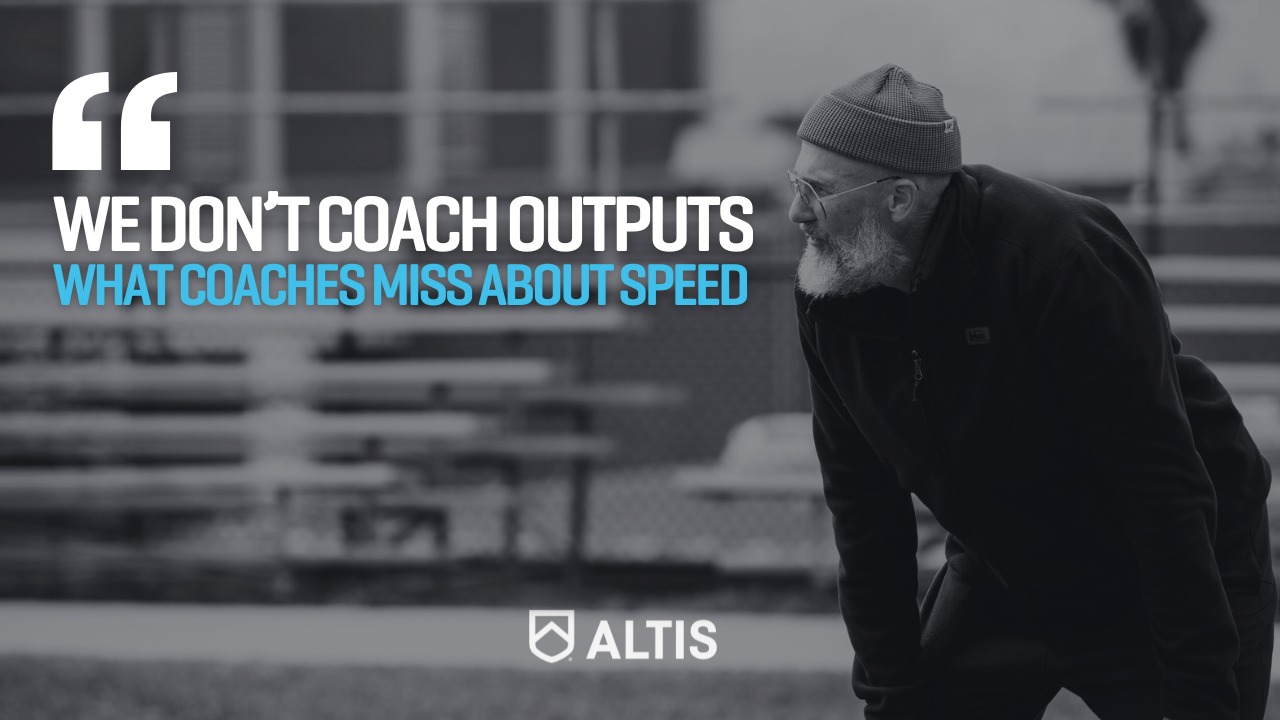“We Don’t Coach Outputs”: What Coaches Miss About Speed
Stu McMillan recently joined Dr. Andrew Huberman on the Huberman Lab Podcast — a platform that reaches millions of curious minds across neuroscience, performance, and human behavior.
In the conversation, Stu brought a coaching perspective that’s rarely heard at that scale: one rooted in movement, not mechanics. In relationships, not recipes. In long-term development, not short-term gains.
Somewhere early in the conversation with Dr. Andrew Huberman, Stu McMillan says something you could almost miss if you weren’t paying attention.
“We don’t coach outputs. We coach the inputs that lead to those outputs.”
He doesn’t say it dramatically. He just states it — plainly, like a coach who's spent decades learning what actually matters.
And in that one line, you get a window into how he sees the process of developing speed — not as a series of technical cues or drills, but as something deeper. More layered. Built, not copied.
It’s a message worth sitting with, especially in a world where performance is often reduced to visible outcomes: stride length, ground contact time, max velocity. But what creates those outcomes? And why do so many athletes struggle to reach them — even when they’re working harder than ever?
The Illusion of Output
There’s a problem with watching elite sprinters and trying to reverse-engineer what you see. As Stu explains, by the time an athlete is running 9.8, you’re watching the result of years of development — not a template you can simply follow.
“People see high-level performances and think, ‘That’s how you’re supposed to run.’ But they don’t understand how that athlete arrived there.”
What you’re seeing on race day is the surface of something much deeper: coordination, rhythm, posture, tissue quality, emotional regulation — all tuned and trained over time. Copying outputs without building the system that produces them is like building a roof before laying the foundation.
The Inputs That Matter
When Stu talks about developing sprinters, he starts far upstream from top-end mechanics. The focus early in the process isn’t speed at all — it’s movement.
“We build a movement vocabulary. Before you ask an athlete to sprint fast, you’d better make sure they can move well.”
This means investing in posture. Joint control. Reactivity. Learning to organize the body in space without tension or compensation. These are the qualities that allow speed to emerge — not because they’re flashy, but because they’re stable.
That work often doesn’t look like sprinting. And that’s the point.
Coaching as Interpretation, Not Intervention
Huberman presses on this — how does a coach know what to change? When do you intervene?
Stu doesn’t offer a checklist. He offers a mindset.
“You have to watch. You have to see the pattern behind the pattern. Sometimes what looks like a technical flaw is actually a compensation. So you don’t fix it — you trace it.”
This is what separates coaching from instructing. You’re not handing out cues like prescriptions. You’re observing. Interpreting. Giving space for the movement to teach the athlete — and for the environment to do some of the heavy lifting.
That approach demands restraint. And patience. But it builds athletes who aren’t just fast — they’re adaptable, aware, and durable.
Where to Begin
For coaches reading this, the takeaway isn’t to abandon technique work or ignore outputs. It’s to shift your lens.
Start with what the athlete can do well. Build a base of movement literacy. Use environments and constraints to develop qualities like rhythm, timing, and fluidity — long before max velocity becomes the focus.
“Most of what we do early on isn’t sprinting,” Stu says. “It’s preparing the athlete to handle sprinting.”
That kind of preparation doesn’t show up on a stopwatch. But over time, it shows up everywhere else.
Hear the Full Conversation
This is one of many threads Stu unpacks in his hour-long conversation with Andrew Huberman. It’s a rare blend of practical experience, philosophical clarity, and straight talk — exactly the kind of insight the coaching world needs more of.
Want to Learn More from Stu?
If you're working with athletes or clients who haven’t sprinted in a while — or ever — Stu has created a practical guide to help you introduce sprinting safely and effectively.
It covers how to lay the groundwork, avoid common pitfalls, and build the right progressions — especially for general population, field sport athletes, or return-to-play scenarios.
Access Your Free Video Guide: Why You Shouldn’t Even Think About Sprinting — Do This First...
Simply drop your details on the form below, and we'll email you with free access right away!

